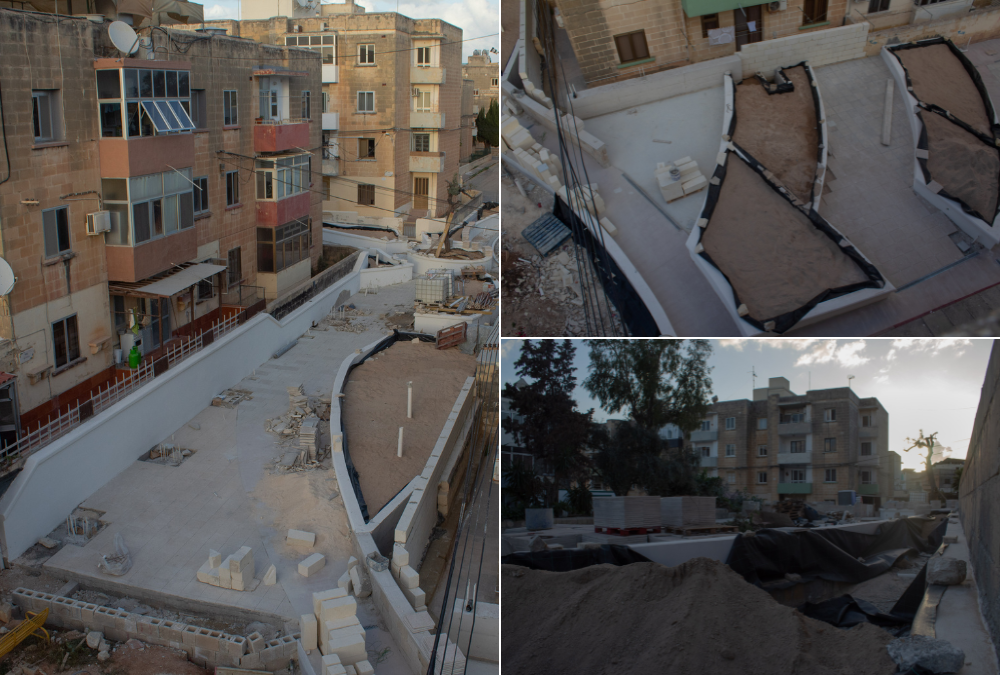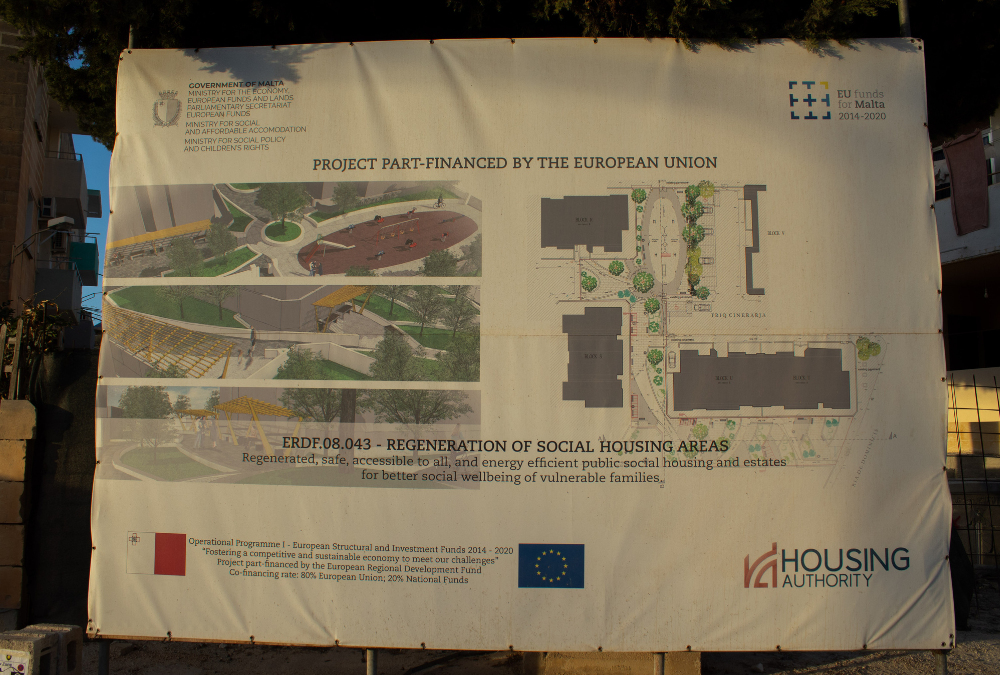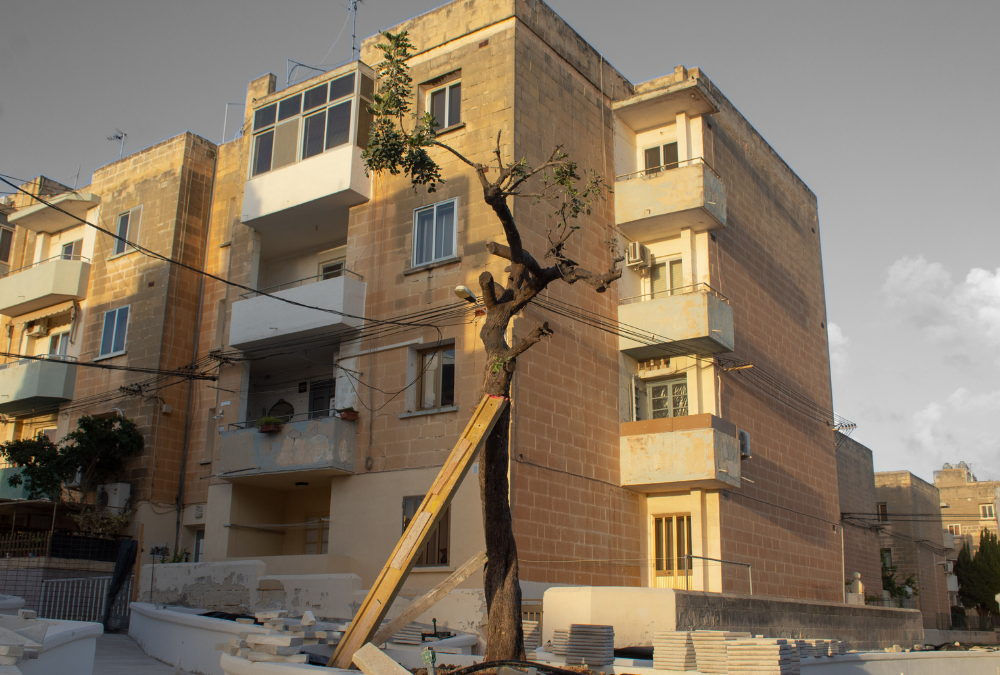This is an investigation that is split into a total of four separate articles. This article is the fourth and last one in the sequence. The links to the other parts of the investigation can be found at the bottom of the main article, which you can access by clicking here.
Residents in the area near Triq Katerina Vitale and Triq il-Fortizza approached this website towards the beginning of November to voice their concerns about a Housing Authority project which, following a year and a half’s worth of intensive roadworks around the locality of Santa Luċija, meant a total of around four years of “getting covered in dust and debris” in what they described as a “constant assault”.
One of the residents, who is being identified with the pseudonym Lucy for the purposes of this story, expressed how this “constant assault” of nearby roadworks and later, a much maligned ’embellishment project’ carried out by the Housing Authority around their block, has affected her psychologically. The assault is only set to intensify as an onslaught of major developments picks up the pace.

Photos of the ’embellishment’ works being carried out near Triq il-Fortizza. Photo: Julian Delia
- A view of the area before the ’embellishment’ works were carried out.
- A view of the area before the ’embellishment’ works were carried out.
“I always end up thinking – ‘who knows what new projects they’re going to cook up now, which road is being resurfaced, or which building is coming up next’. Almost every month, there would be an announcement of a new major development happening in the locality. I’m not talking about projects which are strictly beneficial to residents. I’m talking about projects which completely change the aesthetics and the environment which we live in,” Lucy explained.
Another resident who spoke to this website, who is being identified with the pseudonym Ben for the purposes of this story, concurred with Lucy’s assessment of the situation. Both of them described how practically nobody who lives in the nearby social housing blocks approves of this embellishment and many questioned why it was even necessary.
To begin with, the reservoir that is being built is not necessary since there is another unused one nearby, mature trees were cut down to make way for saplings planted in shallow patches of soil, and a playground that was not really necessary is being built regardless even though there is an abandoned playground in the nearby Ġnien iċ-Ċiniżi that could be refurbished and a functional playground in the square.
Given the lack of a clear rationale for this project – questions have been sent to the Housing Authority to determine what the rationale was to begin with – both Ben and Lucy suggested that they wouldn’t be surprised if these unwanted embellishment works were being carried out to simply make use of EU funds rather than let them go to waste as well as to complement the major residential project that is being proposed across the road.

The major project across the road, of course, is none other than the hotly contested residential complex proposal – 35 apartments, four maisonettes, and 74 garages – that was filed by major developer Anton ‘Tal-Franċiż’ Camilleri, the same developer who has documented ties with economy minister Silvio Schembri.
“It’s absolutely unwelcome. This is a massive project that will change an entire locality and turn it into a mini-city. If you count all the apartments they will build and the amount of people this will bring, it changes everything,” Ben said when asked to describe Camilleri’s proposed residential complex.
While the planning permit for the Housing Authority’s embellishment works was filed in 2019, works did not start until 19 August 2022, when a gate was erected around the perimeter of the site. In April of that same year, a few months before the authority’s works actually started three years late, Camilleri filed a planning application for a development across the street. Both Ben and Lucy suspect that the Housing Authority deliberately timed the works to coincide with the expected approval of Camilleri’s project.

A Google Maps screenshot indicating the outline of the respective permits (red marks the site for the proposed Tal-Franċiż development, blue marks the site in which the Housing Authority’s ongoing works are being carried out.
Questions have been sent to both Camilleri’s group of companies as well as the authority in question to give them time to rebut the allegations being leveled in their regard. Camilleri did not respond to this website’s request. After several phone calls, a communications spokesperson for the social accommodation ministry did not send answers to questions which were sent in writing.
Describing the area around her home before the authority’s embellishment works – a term which Lucy refuses to use because of how the area’s been completely butchered since then – she explained how at no point in time was there any kind of perceived need for the project. She also described a lack of responsiveness from the authorities, a feeling which Ben also acknowledged whenever he attempted to discern a timeline for the conclusion of the works.
“There was an apartment block with trees that were already there and with lots of patches of soil. All it needed was some regular maintenance from the council and maybe walls which were slightly higher, and it would have been perfect. The tall trees provided for a bit of separation between the apartment blocks, providing some privacy. It was also really nice to wake in the morning and hear the birds sing. This was imposed on us without any consultation or at least, some advance notice,” she said.
“They just showed up, closed off the area, and began carrying out works. They provided unclear explanations about why, in a residential zone, they’re building a water reservoir, a playground, and just digging up everything. Along the way, the project began, then stopped abruptly. Workers used to come and then go. In summer, we had a big problem with bad smells, mosquitoes, dust everywhere. We spent months like that,” she added.
Much to their dismay, both Ben and Lucy reported that the Labour-led local council did not provide them with any kind of tangible support whenever they reached out to them. The Housing Authority never responded with clear answers, either.
Both of them also looked up to the Nationalist Party’s only local councillor in Santa Luċija, Liam Sciberras, as the only trustworthy point of reference on the council. Ben referred to the Labour Party representatives of the council as “compromised” due to their direct association with the same political party whose deputy leader is also occupying the role of architect for the Tal-Franċiż project as well as their failure to adequately represent residents’ interests in cases involving other major developments.
“At one point, I had to stop trying to figure out what’s going on because I was getting too many palpitations. I had to stop and leave it in the hands of the local councillor, Liam. Thank God he was there, and do mention this, because he is the only one who did anything about all of this. Psychologically, my mental health felt like it was regressing a lot, just from trying to understand what was going on and what can be done to correct the wrong decisions that others made for you,” Lucy said.
Inevitable comparisons with Shanghai and Dubai were drawn throughout both of the conversations when the subject of the future of the urban landscape of Santa Luċija and the country at large. Lucy, in particular, speaks about how people just can’t be blamed for wanting to leave the country when living here demands a constant struggle to safeguard the environment from over-development.
When asked about what she thinks needs to change to address Malta’s addiction to construction and what her message to readers would be in the context of the situation in Santa Luċija, she speaks about the need for residents to remain vigilant, united, and loud, because one of this country’s biggest problems is the fear of facing repercussions.
“Fear lulls the mind to sleep, and we’ve been like this for decades now,” she concludes.
The questions that the developer and the Housing Authority did not answer
The developer:
1) The overwhelming majority of the locality of Santa Luċija is opposed to this project. NGOs have also opposed this project, along with the local council.
Among the litany of reasons – besides the negative impact the project will have on the identity and character of the locality – objectors stated that:
– the proposal exceeds the height limitation on all four facades,
– the proposal will lead to the removal of a green lung to make way for the development,
– the building will be two – three floors higher than surrounding buildings,
– the proposal has 4.66 times more than the current average unit density of the area,
– there were previous refusals for smaller developments in the area (PA/1432/20),
– there will be a huge negative impact on their well being during the construction phase of the project.
Does the developer believe that the objections listed above are valid enough for the project to be withdrawn? Why / why not?
2) The architect for this project is Daniel Micallef, who also serves as the Labour Party’s deputy leader for party affairs. What is the nature of your company’s relationship with Micallef’s firm? Given his involvement in politics and the party’s electoral pledge to preserve green spaces such as the one you are seeking to develop, do you feel like your choice of architect places him in a position of direct conflict of interest?
3) How do you respond to accusations that the choice was made deliberately with the intent of using Micallef’s influence within the Labour Party to obtain a favourable outcome for your proposed development?
4) Generally, how do you respond to accusations of undue influence over the Labour government, especially in light of documented instances of dubious conduct from authorities in charge of issuing tenders which were crucial to your projects?
The Housing Authority:
1) Residents in the area informed me that nobody who lives in the nearby social housing approves of this embellishment and many questioned why it was even necessary. To begin with, the reservoir that is being built is not necessary since there is another unused one nearby, mature trees were cut down to make way for saplings planted in shallow patches of soil, and that a playground was not really necessary since there is an abandoned playground in Ġnien iċ-Ċiniżi and a functional playground in the square.
What was the Housing Authority’s rationale for this specific project? What need did the authority identify and seek to address with this project? How much funding was spent on the project, both in terms of government funds and in terms of EU funds? And why does the public application for PA/5015/19 explicitly state that no EU funding was used when EU funding was, in fact, used for this project?
2) While PA/5015/19 was filed in 2019, works did not start until 19 August 2022 when a gate was erected around the perimeter of the site. In April of that year, major developer Anton Camilleri filed a planning application for a development across the street.
Residents who spoke to this website accused the Housing Authority of deliberately timing the works to coincide with the expected approval of Camilleri’s project.
How does the Housing Authority explain the three year delay? How does the Housing Authority respond to this accusation?
3) Residents flagged multiple instances in which project delays were communicated to them informally either by the project contractor or after making several enquiries with the Housing Authority. We are informed that there were several instances in which the contractor did not show up or claimed a lack of availability for extended periods of time and that nearby buildings faced structural problems caused by damage from the embellishment works.
Has the Housing Authority taken remedial action in this regard? Have residents been compensated for any inconveniences or damages incurred as a result of this embellishment which they didn’t want or ask for in the first place?




